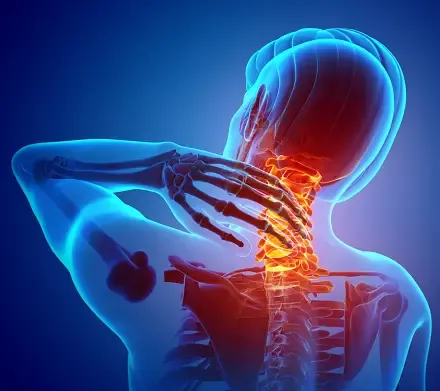john@lee-mat.com
+86-13510662576

GET QUOTE
The Root Causes of Neck Discomfort
Neck pain is a widespread issue affecting individuals of diverse backgrounds and ages. Gaining insight into the origins of this discomfort is pivotal for both prevention and successful treatment. This article will explore various factors contributing to neck pain, with a particular emphasis on muscle strain, poor posture, and injuries.
Muscle Strain
A primary instigator of neck pain is muscle strain. The neck muscles can experience strain due to factors like overexertion, excessive physical activity, or sudden movements. Inadequate body mechanics during activities such as weightlifting, repetitive lifting, or carrying heavy loads can impose strain on the neck muscles. Additionally, prolonged periods of suboptimal posture, such as slouching over a desk or cradling a phone between the shoulder and ear, can contribute to muscle strain, resulting in localized pain, stiffness, and restricted range of motion.
Poor Posture
In the contemporary digital era, poor posture has become increasingly prevalent, leading to a surge in neck pain cases. The habitual use of electronic devices, such as smartphones and laptops, often prompts individuals to tilt their heads forward and round their shoulders. This position, commonly referred to as "text neck" or "tech neck," places excessive strain on the neck and upper back muscles, culminating in persistent discomfort. Additionally, extended periods of sitting with improper ergonomics, such as slouching or using an uncomfortable chair, can foster poor posture and subsequent neck pain.
Injury
Neck injuries can arise from accidents, sports-related incidents, or sudden impacts. Whiplash, a frequent injury following motor vehicle accidents, involves the neck jerking forward and backward abruptly. This forceful movement can strain the neck's soft tissues, including muscles, ligaments, and tendons, leading to pain and stiffness. Sports activities involving contact, collisions, or sudden changes in direction can also result in neck injuries. Timely medical attention is essential if a neck injury is suspected, as prompt diagnosis and appropriate treatment are crucial for recovery.
Other Contributing Factors
While muscle strain, poor posture, and injury stand out as primary causes of neck pain, additional factors can also contribute to this condition. Stress and tension can manifest physically, causing neck muscles to tighten and become painful. Medical conditions such as osteoarthritis, herniated discs, spinal stenosis, and fibromyalgia may also give rise to neck pain. Lifestyle choices, including lack of exercise, obesity, and smoking, can weaken muscles and compromise the spine's integrity, elevating the risk of neck pain.
Ways to Help Relieve Neck Pain
Comprehensive Assessment
Physiotherapists are trained to conduct thorough assessments, identifying the underlying causes of neck pain. They evaluate an individual's posture, muscle strength and flexibility, joint mobility, and range of motion. By discerning the specific factors contributing to neck pain, physiotherapists can develop personalized treatment plans tailored to individual needs.
Manual Therapy Techniques
Physiotherapists employ various manual therapy techniques to address neck pain, including soft tissue mobilization, joint mobilization, and myofascial release. Soft tissue mobilization involves applying gentle pressure and stretching to release muscle tension and enhance blood circulation. Joint mobilization aims to restore proper joint alignment and movement, reducing pain and stiffness. Myofascial release targets the fascia, the connective tissue surrounding muscles, to alleviate muscle tightness and pain.
Exercise Prescription
An essential aspect of physiotherapy for neck pain is exercise prescription. Physiotherapists design individualized exercise programs focusing on strengthening weak muscles, improving posture, and increasing flexibility and range of motion. These exercises may include neck stretches, postural correction exercises, and strengthening exercises for the neck and upper back muscles. Regular practice of these exercises helps improve muscle balance, reduce strain on the neck, and enhance overall neck function.
Ergonomic Guidance
Physiotherapists offer valuable guidance on ergonomic principles to optimize posture and reduce neck pain during daily activities. They assess workplace setups, including desk ergonomics, chair positioning, and computer monitor height. By recommending appropriate adjustments, such as using a supportive chair or an ergonomic keyboard, physiotherapists help individuals maintain proper posture and minimize neck strain during work and other activities.
Pain Management Techniques
Managing pain is an integral part of physiotherapy treatment for neck pain. Physiotherapists may employ various pain management techniques, including heat therapy, cold therapy, electrical stimulation, and ultrasound. These modalities help reduce pain, decrease inflammation, and promote tissue healing. Additionally, physiotherapists provide education on self-management strategies, such as applying ice or heat packs, practicing relaxation techniques, and using over-the-counter pain medications as appropriate.
Seeking the expertise of a physiotherapist is a prudent choice for individuals experiencing neck pain. Through comprehensive assessments, manual therapy techniques, exercise prescription, ergonomic guidance, and pain management strategies, physiotherapists can effectively address the root causes of neck pain and provide relief. Embracing physiotherapy as part of a holistic approach to neck pain management can significantly improve one's quality of life.
Conclusion
Understanding the root causes of neck discomfort is the first step towards finding relief. Whether it's addressing poor posture, combating text neck, managing stress, optimizing your workspace, or choosing the right pillow, small adjustments can make a significant impact. With Forever Standing, you have a partner in creating a comfortable and supportive environment for your neck and overall well-being.

